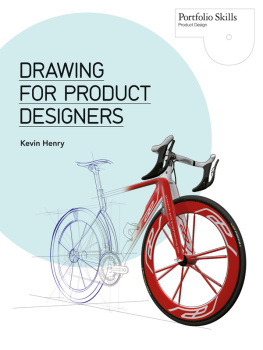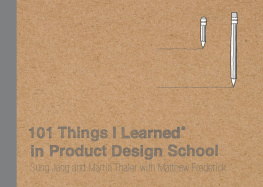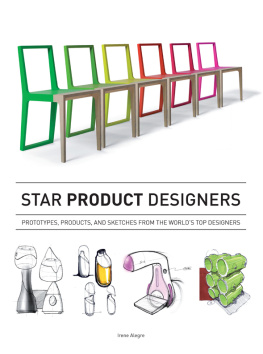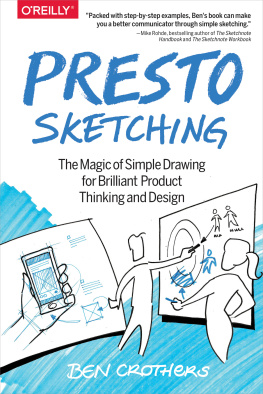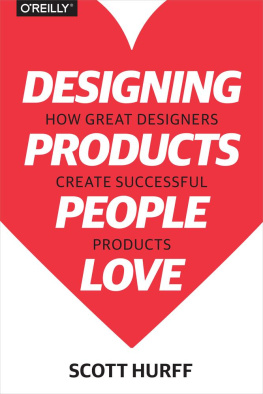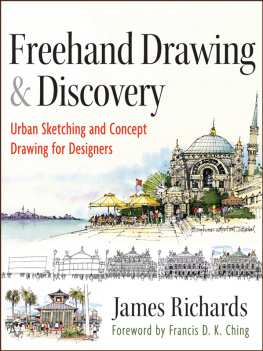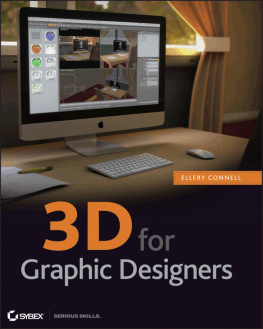Henry - Drawing for Product Designers
Here you can read online Henry - Drawing for Product Designers full text of the book (entire story) in english for free. Download pdf and epub, get meaning, cover and reviews about this ebook. City: London, year: 2017, publisher: Laurence King Publishing, genre: Romance novel. Description of the work, (preface) as well as reviews are available. Best literature library LitArk.com created for fans of good reading and offers a wide selection of genres:
Romance novel
Science fiction
Adventure
Detective
Science
History
Home and family
Prose
Art
Politics
Computer
Non-fiction
Religion
Business
Children
Humor
Choose a favorite category and find really read worthwhile books. Enjoy immersion in the world of imagination, feel the emotions of the characters or learn something new for yourself, make an fascinating discovery.
- Book:Drawing for Product Designers
- Author:
- Publisher:Laurence King Publishing
- Genre:
- Year:2017
- City:London
- Rating:3 / 5
- Favourites:Add to favourites
- Your mark:
- 60
- 1
- 2
- 3
- 4
- 5
Drawing for Product Designers: summary, description and annotation
We offer to read an annotation, description, summary or preface (depends on what the author of the book "Drawing for Product Designers" wrote himself). If you haven't found the necessary information about the book — write in the comments, we will try to find it.
Drawing for Product Designers — read online for free the complete book (whole text) full work
Below is the text of the book, divided by pages. System saving the place of the last page read, allows you to conveniently read the book "Drawing for Product Designers" online for free, without having to search again every time where you left off. Put a bookmark, and you can go to the page where you finished reading at any time.
Font size:
Interval:
Bookmark:
DRAWING FOR
PRODUCT DESIGNERS
KEVIN HENRY
Laurence King Publishing

Drawing for Product Designers
Published in 2012 by
Laurence King Publishing Ltd
361373 City Road
London EC1V 1LR
Tel: +44 20 7841 6900
Fax: +44 20 7841 6910
email: enquiries@laurenceking.com
www.laurenceking.com
Design 2012 Laurence King Publishing Limited
Text 2012 Kevin Henry
Kevin Henry has asserted his right under the Copyright, Designs, and Patent Act 1988, to be identified as the Author of this Work.
All rights reserved. No part of this publication may be reproduced or transmitted in any form or by any means, electronic or mechanical, including photocopy, recording, or any information storage and retrieval system, without permission in writing from the publisher.
A catalog record for this book is available from the British Library.
ISBN: 978 1 85669 743 9
Series and book design: Unlimited
Project editor: Gaynor Sermon
Printed in China
Authors dedication:
To my wife Doro for such long and unbending love and to my daughter Klara for the joys that only children can bring.
Related study material is available on the Laurence King
website at www.laurenceking.com

CONTENTS
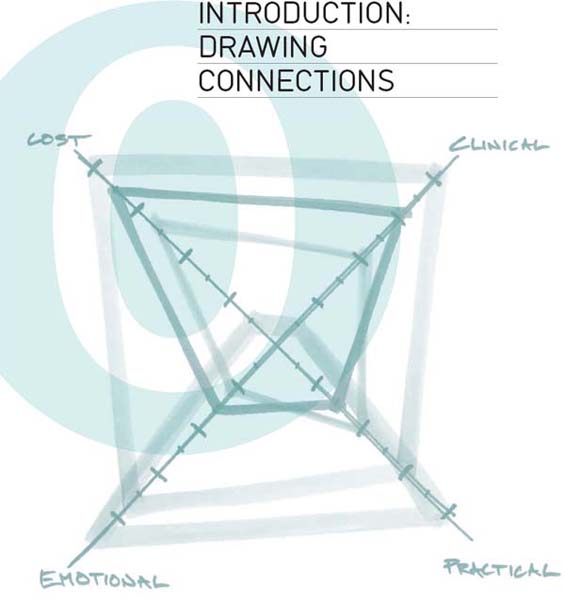
Fig. 1
This sketch from HLBs Boston office is an early iteration of a design diagram intended to visualize complex research data in a way that will make it clearer to both the design teams and the client.
Why read this book?
Sketching remains the fastest and most direct method for designers to get ideas out on paper, whether they work in a collaborative setting or solve problems alone. It can be differentiated from drawing by its level of refinement: drawing tends to be more deliberate and accurate, following on from the initial sketching process. Sketching should not, however, be thought of as simply giving form to objects and spaces; it should be seen more universally as a tool for thinking, planning, and exploring. It is used by a wide range of people including scientists, mathematicians, engineers, economists, and coaches to help explain, provide instruction, or simply think aloud on paper. In a world of increasingly complex and instantaneous information, quickly sketched visualizations can help simplify and compress data far more efficiently than language. Sketching can also help visualize interactions or scenarios for smart devices such as mobile phones or services more generally.
Sketching, like writing, works in two waysit can be active (like writing) or receptive (like reading)but it is different to writing primarily because of its immediacy: sketched marks often correspond one-to-one with what they represent. And while some technical knowledge might be required to understand technical drawings, most sketches can be read by anyone, anywhere, with seemingly little effort.
Drawings real power lies in its immediacy and speed; its capacity to materialize thoughts and ideas quickly so that they can be expanded upon or shared before they disappear. The designer uses lines and marks to shepherd ideas into existence while they are still only partially formed in his or her mind.
This processa cumulative rather than linear oneallows the designer to go back to a sketch and add to, or subtract from, it or simply revisit ideas on paper and continue the thinking process begun earlier. Such sketch ideation is not simply a matter of documentation or observation; instead it is a highly creative and dynamic act where the power and poetry of line can capture character and begin defining form or clarifying connections thereby enhancing communication. Sketching can be used to show cause and effect, time-based interactions, or form factors.
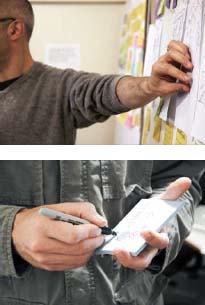
Fig. 2
The design process is extremely varied. It relies on many different ways of recording, organizing, and refining ideas including: Post-it notes, quick sketched doodles or handwritten notes, color coding or spatial organization, diagramming, and flowcharting. Sketching is vital to every one of these methods because of its speed and provisional nature.
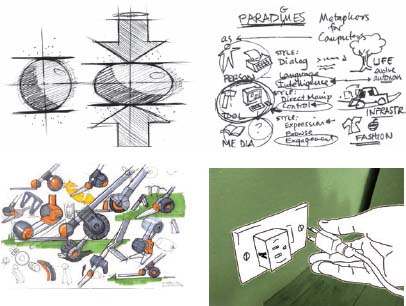
Fig. 3
The many ways in which sketching can assist in the design process include general diagrams, cause and effect sketches, quick ideation sketches, scenario-based sketches, and concept renderings. While all these forms are different they also have a great deal in common.
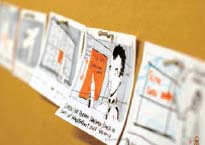
Fig. 4
These storyboard sketches from Gravity Tank are used as a preliminary tool to flesh out a particular problem or set of issues. The simple cartoonish sketches provide a quick and approximate method for getting the details of potential stories out, and are a refined way to envision potentially larger and more detailed stories. The final deliverable presented to the client is often a high-fidelity video presentation with sound and minimal animation, to create an engaging and captivating story.
Over time these skills evolve into a singular, consolidated method as the designer matures and gains the confidence required to push and pull unrealized ideas on paper or a computer screen. Understanding the ways in which these skills can work separately, as well as how they can be leveraged and merged for stronger visualizations, is critical to any design practice. Sketching, drawing, and visualization in general become inseparable from design thinking.
In order to create a bridge between freehand sketching skills and digitalbased visualization tools, I have devised a unique system that utilizes the language and techniques of both approaches: analog and digital. The method is grounded in the long and rich history of perspective, which informs contemporary computer software, as well as current and past theories of the cognition and vision so critical to understanding how humans see and think. The explanations and tutorials in this book clearly demonstrate how to visualize ideas quickly and effectively. Applying the logic and processes of computer-aided design to analog sketching helps to amplify and clarify many drawing techniques while allowing for a smoother transition between paper and computer.
For this book, hundreds of hand-drawn sketches have been scanned or re-traced in the computer and line art from computer models has been created specifically to demonstrate the connection between the analog and digital. The reader will learn to think fluidly in a three-dimensional world and, through practice, be capable of building complex design ideas that are structurally sound and visually clear. Central to the book is the idea that many design disciplines are blurring their boundaries. Skills that have been important to architects and industrial designers are becoming equally important to illustrators and information designers, and vice versa. This is reflected in the reality that designers (of every discipline) are using similar digital tools (vector-based graphics, raster-based photo manipulation software tools, computer-aided design, and time-based animation software).
Next pageFont size:
Interval:
Bookmark:
Similar books «Drawing for Product Designers»
Look at similar books to Drawing for Product Designers. We have selected literature similar in name and meaning in the hope of providing readers with more options to find new, interesting, not yet read works.
Discussion, reviews of the book Drawing for Product Designers and just readers' own opinions. Leave your comments, write what you think about the work, its meaning or the main characters. Specify what exactly you liked and what you didn't like, and why you think so.

